A clean pet is a healthy pet. If you are committed to taking care of it, then you must clean them and their environment on a regular basis. Their surroundings are even more important, especially if your pet is living in a cage. You’re running the risk of exposing your guinea pig to bacterial growth, fungal infections, and some nasty diseases if you don’t keep it clean.
Do guinea pigs need baths and do they enjoy them? Guinea pigs need baths but not very often. Short-haired guinea pigs can be given a bath once or twice a year while the long-haired guinea pigs are every two to three months (only if they are dirty and smelly). Guinea pigs don’t actually enjoy the water, unlike other common pets (a cat or a dog).
In this article, we are going to go over everything related to guinea pig baths and give you an instructional guide for bathing and grooming. Let’s start!
Table of Content
Reasons Not to Bathe Your Guinea Pig Often
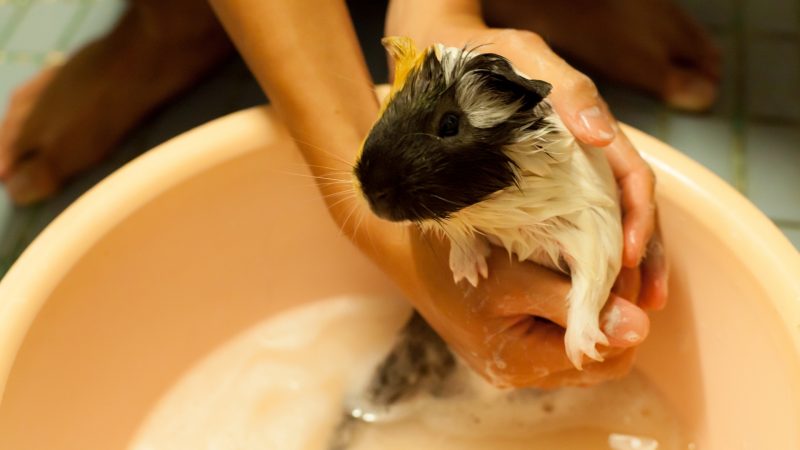
There are a couple of reasons why you shouldn’t bathe your pet guinea pigs often:
Guinea pigs can clean themselves.
Your guinea pigs are excellent self-groomers especially the short-haired ones, so they don’t really need to hop on the bathtub often. So in most cases, you can just let them take care of their coat and fur themselves.
Bathing them removes the natural oils on their skin.
Especially if you use shampoo for humans, which is not advisable to do, this will strip the natural oils from your guinea pigs’ coats. This will make their skin dry, which will do more harm than good.
That might create an allergic reaction. It will expose them to even more bacterial or fungal infections on their skin as this layer of oil will take a couple of days to a few weeks to regenerate.
Your guinea pig might become chilled and stressed.
Most guinea pigs don’t like water for any purpose other than drinking it, and it is also true for some other domestic animals like cats. If your pet guinea pig finds bathing stressful and chills a lot after bathing, especially during the winter season, it will catch colds and get sick easily.
It might be best to wipe them instead with a damp washcloth or unscented baby wipes to remove urine or feces from their fur.
Their cage is clean and only has short-haired guinea pigs.
Some guinea pigs only take a bath once or twice during the whole year. This is only possible if you always keep their cage clean and you only have short-haired guinea pigs.
Short-haired guinea pigs don’t smell or get dirty that easily, so they shouldn’t need to take a bath. However, if their fur gets sticky and heavily soiled, you need to clean them.
Even with long-haired guinea pigs like Peruvian guinea pigs, they need regular grooming, but you should only bathe them once a month at most. You probably will only need to wash their bums when their coat gets soiled.
When Should You Bathe Your Guinea Pig More Than Once a Month?
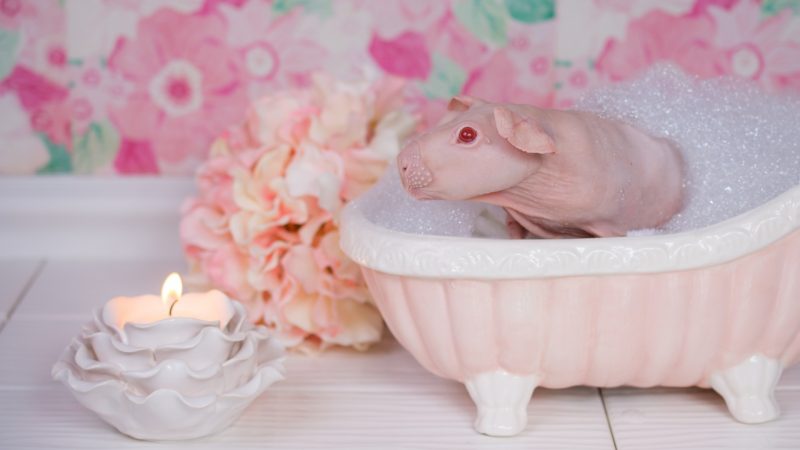
- When your exotic vet tells you to. There are several illnesses that will require you to bathe your pet guinea pigs often like when your pets are infested with lice, mites, fleas, or if they have fungal infections like ringworm. However, follow the vet’s instructions carefully on how often you should bathe your pets, what particular shampoo to use on their coat, and what to look out for while bathing them. Diarrhea can also make guinea pig’s bum filthy, so just wash that part only.
- When your pets have extremely dirty fur. If your pet is only dirty on one spot like its bum, wiping it clean with a towel or just washing that part is enough. In case its whole body’s fur is highly felted, then you can consider giving it a full bath.
- When you are grooming your pet for guinea pig shows. You would want your pet to look and smell its best during pet shows, so you need to bathe your pet before taking it to the show.
Never Bathe Your Guinea Pig Under the Following Conditions
- If the guinea pig is under six months old.
- The guinea pig is suffering from any sickness especially respiratory illness.
Related: Are Guinea Pigs Hard to Take Care Of?
Necessary Equipment for a Guinea Pig Bath
- Container or a big bowl with a washcloth underneath – This is where you’ll bathe your pet so it won’t slip or slide. The container must have sides that are high enough that your guinea pig won’t be able to jump out.
- Towels – One for shampooing your guinea pig and another one or two for drying your guinea pig after a bath.
- Special shampoo for guinea pigs – Ask your exotic vet for recommendations. In the case of parasitic infestations or fungal infections on your guinea pig, your vet will prescribe a different shampoo. If you can’t find any shampoo recommended for guinea pigs, then you can check this recommendation.
- Hairdryer with a low setting
- Guinea pig brush for grooming
How to Give a Guinea Pig a Bath? | Step by Step Instructions
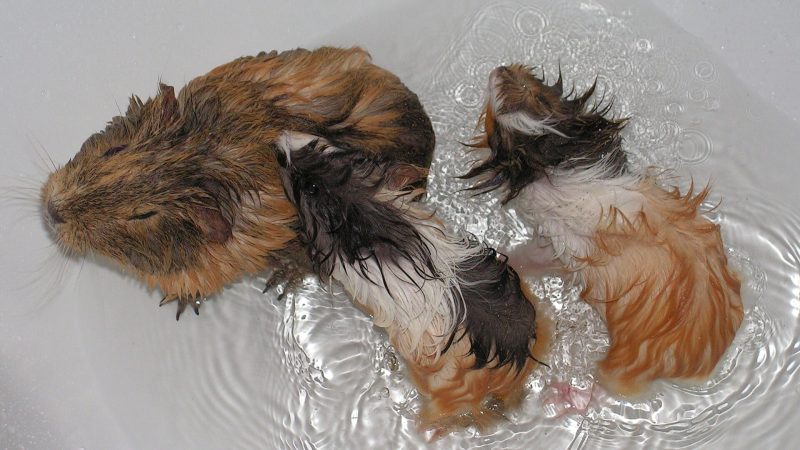
Step 1: Pour Warm Water Onto Your Container
As a rule of thumb, the water should just reach a guinea pig’s belly when it stands up in the container.
Step 2: Calm Your Guinea Pig First Before Bathing It
Your guinea pig might become anxious and stressed once you start bathing it, so you need to relax it first. To do this, you can pet its fur gently or give it a treat. Do this while you are bringing your pet to the bath area.
Step 3: Slowly Lower Your Guinea Pig Into the Container
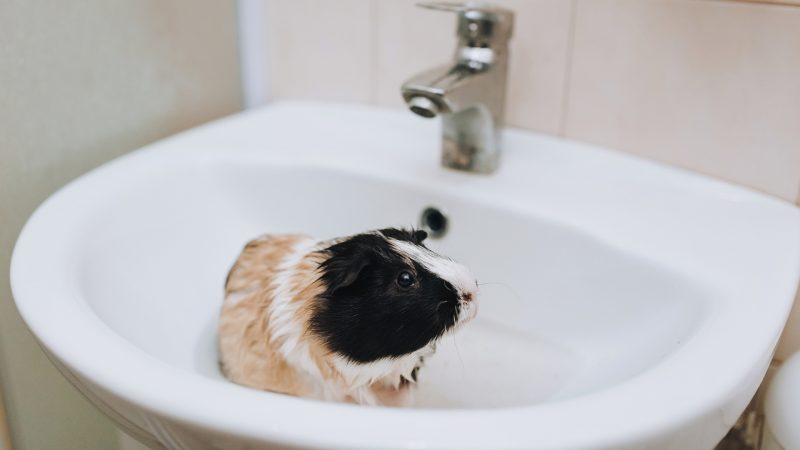
You may want to touch the warm water with one of its feet first so it can get used to it. Another tip is to have a veggie treat nearby to distract it while you are lowering it into the container.
If your guinea pig is wriggling too much, take the container and put it in a bathtub so your pet won’t be able to jump out and get away.
Step 4: Watch the Water Level
Make sure that your guinea pig’s nose and mouth are out of the water when it is standing up. Give it a few minutes in the water to adjust. Gently pour water onto its back. Avoid getting water onto its eyes, nose, ears, and mouth.
Step 5: Apply the Shampoo
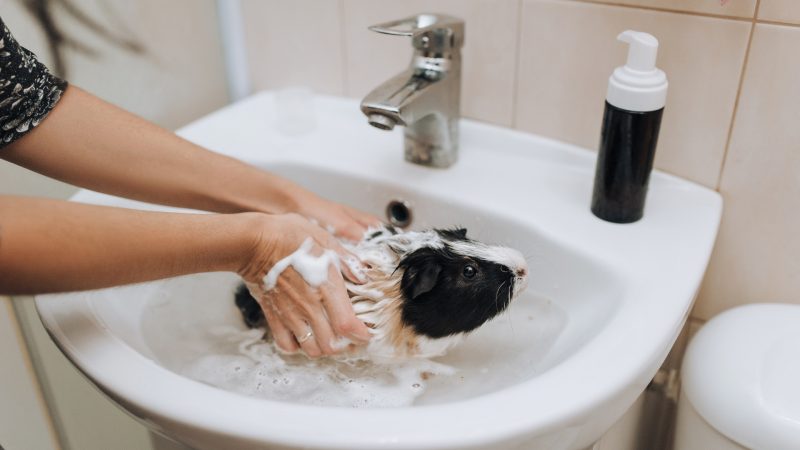
Once thoroughly wet, lift your guinea pig with a towel and let the excess water drip on it. Start lathering its body gently with shampoo, again avoiding its head and parts of the face.
If your guinea pig’s head is really dirty, lather shampoo on it with your finger. Avoid getting any shampoo on its eyes. If you’re giving your pet an anti-parasitic bath, follow carefully any special instructions written on the prescribed shampoo.
Note: You can use this moment to gently feel your pet guinea pig’s body for any bumps or lumps.
Step 6: Rinse Your Guinea Pig With Water
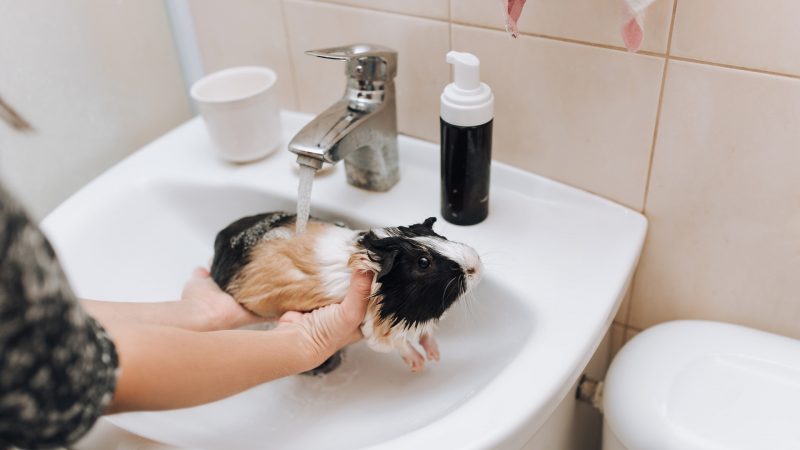
Once you’ve shampooed your guinea pig thoroughly, put it back into the container and rinse two to three times. Change the water for every rinse until all the residue of shampoo has been washed away.
Step 7: Slowly and Gently Apply the Towel
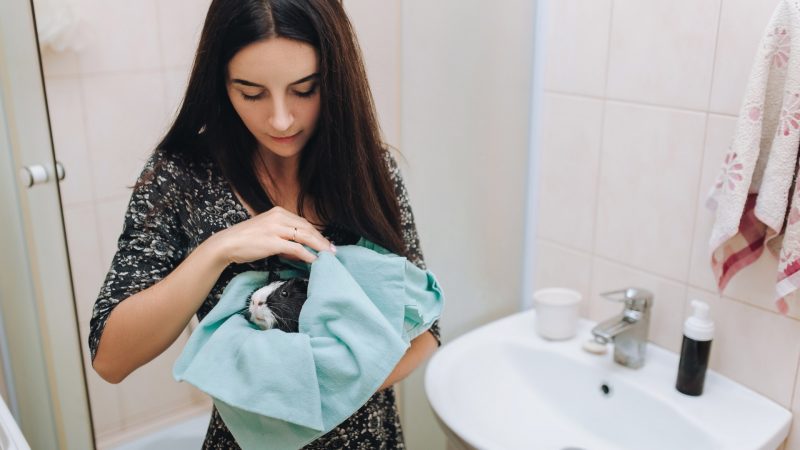
Lift your guinea pig out of the water and place it on the other dry towel. Gently wrap up your pet with the towel and dry its fur. Don’t fret if your pet starts shivering but keep towel drying until the shivering stops.
Press gently on its body with your towel but try to dry it as quick as possible to prevent chills. You may want to use another dry towel if the one you’re using gets too damp.
Step 8: Dry Your Guinea Pig Completely
Fully dry your guinea pig’s fur with the hairdryer. Use the lowest settings in order not to burn your pet. Keep moving the dryer but avoid its ears and then brush its fur while you’re blow-drying it to remove tangles. Make sure your pet is completely dry before putting it back in its cage.
Related: How to Give Guinea Pigs A Bath?
Guinea Pig Grooming | Instructional Guide
While bathing your guinea pigs should be done rarely, grooming them should be done regularly. It is the best way to keep your guinea pigs clean. It is also a great way to increase your bond with your pets.
Here are some basic tips for grooming your pet guinea pigs:
Brush Hair
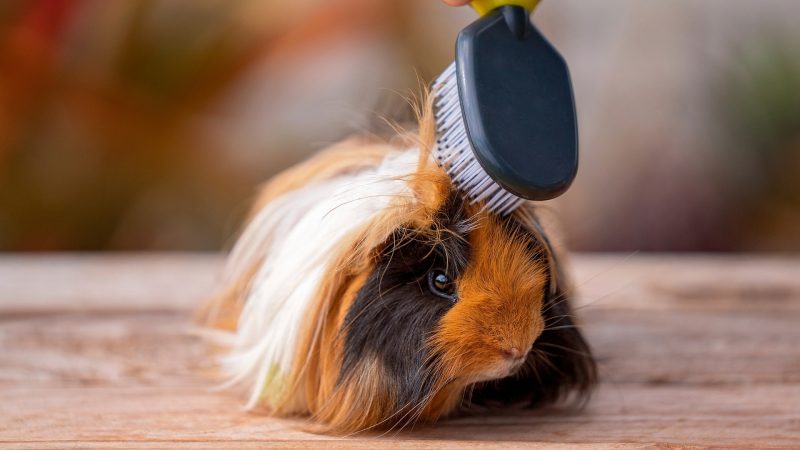
For short-haired guinea pigs, you should regularly brush their coats once or twice a week. It is a different story with long-haired guinea pigs though, as you need to do it daily to prevent hair tangling and matting of their fur. Use narrow-toothed pet combs for brushing.
Most guinea pigs enjoy being brushed because the motion is similar to petting. You should also use this opportunity to feel any lumps or bumps on your pet.
Trim Nails
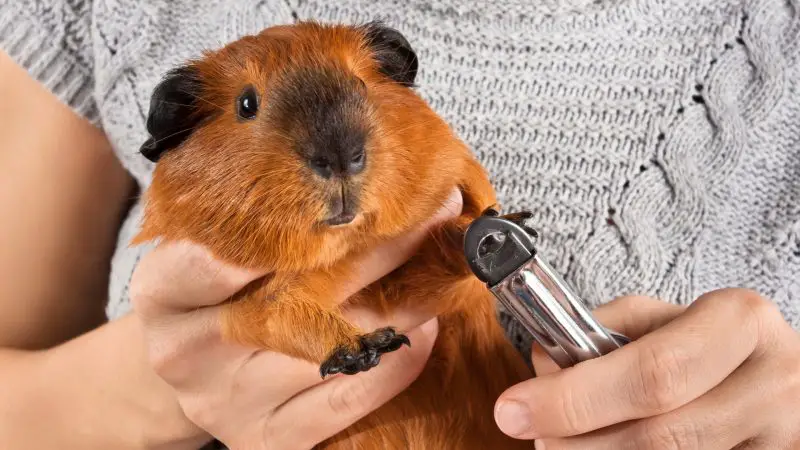
Most guinea pigs are not comfortable having their nails trimmed, but you should do it nevertheless at least once every 4 to 8 weeks. You may consult the help of an exotic vet so he can show you how to do it or he can trim your pets’ nails for you.
Regardless, you should never try clipping your pets’ nails if you don’t know what you’re doing. This is because of “quick” which is a blood vessel at the center of the nail. If you accidentally clip this part along with the nail, it will result in pain and bleeding to the poor guinea pig. Use grooming scissors and not the nail clipper that you use on your nails!
Clean Grease Gland
The grease gland is a small area of skin on a guinea pig. It is located at the base of its spine just above its anus. The need to clean this area differs for every guinea pig, but most male guinea pigs have an active grease gland that secretes a pungent oil that gets sticky and stinky and can lead to infection if left unchecked.
This can be easily cleaned with a cotton swab soaked in a non-abrasive cleaning agent, butt baths with soap, or by rubbing gently with a dry cloth.
Related: Best Guinea Pig Grooming Kit: A Helpful Guide
Summary
As a commitment to being a loving guinea pig owner, you should learn how to do these grooming tips to keep your guinea pigs clean and healthy. They might be able to groom themselves, but they also sometimes need a little help from you.
Overall, guinea pigs require a good amount of attention and low maintenance, but cleaning them and their environment will make sure that they live a happy and healthy life with you.
List of Sources
Some Common Parasites of Small Laboratory Animals
